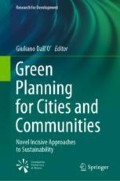Abstract
The design, construction and management of sustainable and intelligent buildings, neighbourhoods and cities require tools that can manage complexity in a completely different manner to the practices adopted to date. This chapter introduces the most advanced current approach, Building Information Modelling (BIM), focusing in particular on its use to support green and smart planning of buildings, neighbourhoods and cities. The initial part of the chapter introduces the general concepts underlying the BIM. The second part explores its application, the Green BIM, intended as the use of the tool to support the sustainable design of buildings. The chapter concludes with the introduction of a more recent concept, the City Information Modelling (CIM), intended as a common platform to design, build and manage the buildings, infrastructures and services of neighbourhoods and cities that evolve towards sustainable and smart schemes.
Access this chapter
Tax calculation will be finalised at checkout
Purchases are for personal use only
Notes
- 1.
- 2.
https://technical.buildingsmart.org, Accessed 20 Sept 2019.
- 3.
Source of definitions https://technical.buildingsmart.org, Accessed 20 Sept 2019.
- 4.
Source: https://urbannext.net/zigurat/city-information-modelling-for-smarter-cities/ Accessed 20 Sept 2019.
References
Ahmada T, Aibinua A, Thaheem MJ (2017) BIM-based iterative tool for sustainable building design: a conceptual framework, international high-performance built environment conference—a sustainable built environment conference 2016 series (SBE16), iHBE 2016. Procedia Eng 180(2017):782–792
American Institute of Architects (2013) Document G202—2013 project building information modelling protocol form
Azhar S, Carlton WA, Olsen D, Ahmad I (2011) Building information modelling for sustainable design and LEED® rating analysis. Autom Constr 20(2):217–224
Azhar S, Brown J, Farooqui R (2009) BIM-based sustainability analysis: an evaluation of building performance analysis software. Available on https://www.researchgate.net/publication/237835268_BIM-based_Sustainability_Analysis_An_Evaluation_of_Building_Performance_Analysis_Software. Accessed 13 Oct 2019
Burry M, Karakiewicz JA, Holzer D, White M, Aschwanden GDPA, Kvac T (2015) BIM-PIM-CIM: the challenges of modelling urban design behaviours between building and city scales. Design modelling symposium copenhagen 2015. https://doi.org/10.1007/978-3-319-24208-8_34
Chong H-Y, Lee C-Y, Wang X (2017) A mixed review of the adoption of building information modelling (BIM) for sustainability. J Clean Prod 142:4114–4126
El-Mekawy M (2010) Integrating BIM and GIS for 3D city modelling: the case of IFC and CityGML. Licentiate thesis, Geoinformatics Division of the Department of Urban Planning and Environment Royal Institute of Technology (KTH) TRITA SoM 2010–11 ISSN: 1653-6126, ISRN KTH/SoM/10-11/SE, ISBN:978-91-7415-790-1
Ente Italiano di Normazione UNI (2017) UNI 11337–4:2017 - Edilizia e opere di ingegneria civile - Gestione digitale dei processi informativi delle costruzioni - Parte 4: Evoluzione e sviluppo informativo di modelli, elaborati e oggetti
Gandhi S, Jupp J (2013) Characteristics of green BIM: process and information management requirements. In: 10th product lifecycle management for society (PLM). Nantes, France, pp 596–605. https://doi.org/10.1007/978-3-642-41501-2_59.hal-01461909
International Organization for Standardization ISO (2018a) ISO 16739-1:2018—Industry foundation classes (IFC) for data sharing in the construction and facility management industries—Part 1: data scheme
International Organization for Standardization ISO (2018b) ISO 19650—organization and digitization of information about buildings and civil engineering works, including building information modelling (BIM)—information management using building information modelling—Part 1: concepts and principles
International Organization for Standardization ISO (2018c) ISO 19650—organization and digitization of information about buildings and civil engineering works, including building information modelling (BIM)—information management using building information modelling—Part 2: delivery phase of the assets
Jalaei F, Jrade A (2015) Integrating building information modelling (BIM) and LEED system at the conceptual design stage of sustainable buildings. Sustain Cities Soc J 18(November 2015):97–107
Krygiel E, Nies B (2008) Green BIM: successful sustainable design with building information modelling. Wiley Publishing, Inc, Hoboken
Kolbe T, Bacharach S (2006) CityGML: an open standard for 3D city models. http://www.directionsmag.com/articles/citygml-an-open-standard-for-3d-city-models/123103. Accessed 15 Sept 2019
Lu Y, Wu Z, Chang R, Li Y (2017) Building information modeling (BIM) for green buildings: a critical review and future directions. Autom Constr J 83:134–148
Maltese S, Tagliabue LC, Cecconi FR, Pasini D, Manfren M, Ciribini Angelo LC (2017) Sustainability assessment through green BIM for environmental, social and economic efficiency. In: International high-performance built environment conference—a sustainable built environment conference 2016 Series (SBE16), iHBE 2016
Pavan A, Mirarchi C, Giani M (2017) BIM: Metodi e strumenti, progettare, costruire e gestire nell’era digitale, Tecniche Nuove, ISBN: 978-88-481-3522-1
Smart Market Report (2010) GREEN BIM, how building information modelling is contributing to green design and construction. McGraw Hill Construction
Shadram SF, Johansson TD, Lu W, Schade J, Olofsson T (2016) An integrated BIM-based framework for minimizing embodied energy during building design. Energy Build 128(2016):592–604
Van Berlo L, De Laat R (2010) Integration of BIM and GIS: the development of the CityGML GeoBIM extension. In: Kolbe TH, König G, Nagel C (eds) 2011: advances in 3d Geo-information sciences. ISBN: 978-3-642-12669-7. In: Cartwright W, Gartner G, Meng L, Peterson MP (eds) ISSN: 1863-2246
Wu W, Issa RRA (2015) BIM execution planning in green building projects: LEED as a use case. J Manag Eng 31(1)
Xu X, Ding L, Luo H, Ma L (2014) From building information modelling to city information modelling. Journal of information technology in construction (ITcon), vol 19. Special issue BIM cloud-based technology in the AEC sector: present status and future trends, pp 292–307. http://www.itcon.org/2014/17
Author information
Authors and Affiliations
Corresponding author
Editor information
Editors and Affiliations
Rights and permissions
Copyright information
© 2020 Springer Nature Switzerland AG
About this chapter
Cite this chapter
Dall’O’, G., Zichi, A., Torri, M. (2020). Green BIM and CIM: Sustainable Planning Using Building Information Modelling. In: Dall'O', G. (eds) Green Planning for Cities and Communities. Research for Development. Springer, Cham. https://doi.org/10.1007/978-3-030-41072-8_17
Download citation
DOI: https://doi.org/10.1007/978-3-030-41072-8_17
Published:
Publisher Name: Springer, Cham
Print ISBN: 978-3-030-41071-1
Online ISBN: 978-3-030-41072-8
eBook Packages: EnergyEnergy (R0)

